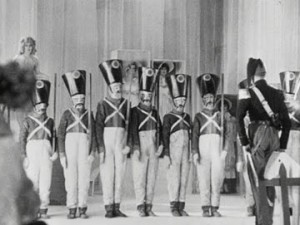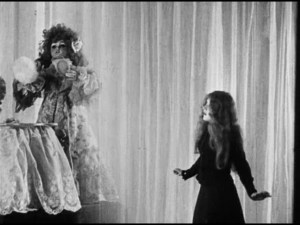From Monthly Film Bulletin, April 1975 (Vol. 42, No. 496). — J.R.
Petite Marchande d’Allumettes, La
(The Little Match Girl)
France, 1928
Directors: Jean Renoir, Jean Tedesco
Cert-U. dist–Contemporary. p–Jean Renoir, Jean Tedesco . asst. d–
Claude H eymann. Simone Hamiguet. Sc–Jean Renoir. Based on the
storv bv Hans Christian Andersen. ph–Jean Bachelet. a.d—Eric Aës.
m -excerpts from works by –Schubert, Strauss, Wagner, Mendelssohn.
m. d–Manuel Rosenthal, Michael Grant. Lp—Catherine Hessling (Karen,
the Little Match Girl), Jean Storm (Young Man/Soldier), Manuel Raby
[Rabinovitch] (Policeman/Death), Amy Wells (Dancing Doll). 1,030 ft.
29 mins. (16mm; also available in 35 mm.). English titles.
Karen leaves her humble-cottage to sell match boxes under a heavy
Snowfall. She gazes wistfully at a handsome young man emerging
from a restaurant, then looks through a frosted pane at the people
eating inside until boys throw snowballs at her. As she gathers up her
spilled boxes a policeman arrives, and together hey look at a display
of dolls and other toys in a shop window. After lighting matches in
an effort to warm herself, she falls asleep and dreams that she enters
the toy shop — having become the same size as the dolls –- and sets
them all in motion. The young man glimpsed on the street appears
as Captain of the toy soldiers and declares his devotion to her,
magically conjuring up a tableful of food; but before she can eat, a
jack–in-the-box identifying himself as Death — another incarnation
of the policeman takes her carving knife and orders the soldiers
and other toys to stop. She and the Captain ride off into the clouds
with Death in pursuit; the men cross sabres, the Captain is slain,
and Death carries Karen’s prone body to a rocky hill and lays her
beneath a cross, which sprouts into a rose tree. Petals falling on her
face merge into snowflakes as the dream fades; passers-by stand
over Karen’s dead body, surrounded by burnt matchsticks in the
snow.
Asked by Rivette and Truffaut in a 1954 interview whether the
trucages in La Petite Marchande d’Allumettes represented his only
“complete experience” in that realm, Renoir replied: “No; I began
making films out of love for trucages. I had no intention of writing,
being an author, inventing stories — my ambition was to make
trucages, and I haven’t done badly since then”. The point is a crucial
one. If this lovely studio-cultured blossom seems at first glance an
exception in Renoir’s career — shot and processed in its entirety in
the attic of the Théâtre Vieux Colombier, in a project so artisanal
and home-made that Renoir and his partner Jean Tedesco supplied
their own electricity, painted the sets, and (with some outside
assistance) built their own lighting system to accommodate their
innovative use of panchromatic stock for interiors — it is a deceptive
first glance. Even as indefatigable a defender of Realism as André
Bazin tries to sneak this film in the back door by defending it as
“the incursion of Renoir’s realism into the themes and techniques
of the avant-garde”, and he is at least halfway right. From the evident
artifice of the toy train chugging through Karen’s impoverished
neighbourhood to the ‘life-like’ sizes and gestures of the toys in her
dream, The Little Match Girl serves as testimony to the unreality of
‘reality’ and the solidity of dreams. Forty-one years later, Renoir
expresses the same notion in the first episode in his Petite Théâtre,
explicitly harking back to his love of Andersen and evoking the
earlier film while inverting some of its details (such as emphasizing
the restaurant diners’ view of the beggar instead of the other way
round, and reducing the dream itself to a single image) to arrive at a
comparable conclusion. Even before she enters the momentary
solace of sleep, Karen is herself a figure of pure fantasy in the
measured doll-like comportment of Catherine Hessling. And much as
her match flames briefly illuminate visions in her mind’s eye (an
enormous sunflower, a Léger-like Christmas tree), thereby equating
life itself with the capacity to dream, the fancy table of food she is
unable to enjoy in the dream expresses her actual hunger more
concretely than her glimpse of guests in the restaurant. Renoir has
noted that neither the music accompanying the film nor the titles
belong to his and Tedesco’s conception (a different score was
originally prepared for a small ‘live’ orchestra, and no titles at all
were intended), and the faded textures of the print under review
suggest a further loss, but far from an essential one: the beauty and
splendor of Renoir and Tedesco’s attic of wonders still shine
implacably through the ravages of nearly half a century.
JONATHAN ROSENBAUM



